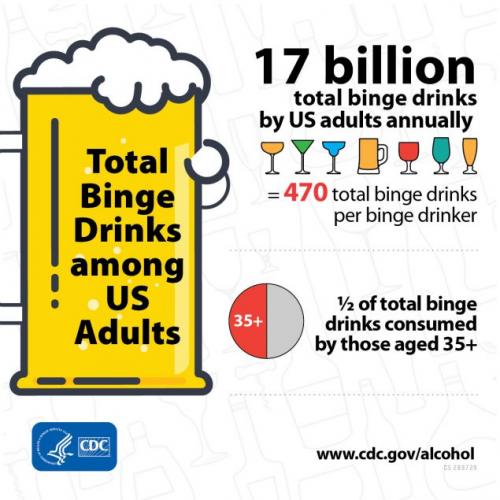During binges, U.S. adults have 17 billion drinks a year
More than half of those drinks are by adults ages 35 years and older
U.S. adults consumed more than 17 billion binge drinks in 2015, or about 470 binge drinks per binge drinker, according to a first-of-its-kind study released by the Centers for Disease Control and Prevention (CDC). The study appears in the American Journal of Preventive Medicine.

17 Billion total binge drinks by US adults annually = 470 total binge drinks per binge drinker. One-half of total binge drinks consumed by those aged 35+.
CDC researchers found that 1 in 6, or 37 million, adults binge drink about once a week, consuming an average of seven drinks per binge. Binge drinking is defined as consuming five or more drinks for men, or four or more drinks for women, in about two hours.
“This study shows that binge drinkers are consuming a huge number of drinks per year, greatly increasing their chances of harming themselves and others,” said study co-author Robert Brewer, M.D., M.S.P.H., lead researcher in CDC’s alcohol program. “The findings also show the importance of taking a comprehensive approach to prevent binge drinking, focusing on reducing both the number of times people binge drink and the amount they drink when they binge.”
For this report, CDC scientists analyzed data on self-reported binge drinking during the past 30 days from CDC’s 2015 Behavioral Risk Factor Surveillance System (BRFSS). Total annual binge drinks was calculated by multiplying the estimated total number of binge drinking episodes among binge drinkers by the average largest number of drinks consumed per episode, and was assessed by age, sex, education, race/ethnicity, household income, and state.
Binge drinking varied by age, sex, and social factors
New insights on binge drinking reported in the study include:
● While the prevalence of binge drinking was more common among young adults ages 18-34 years, more than half of the binge drinks consumed each year were by adults ages 35 years and older.
● About 4 in 5 total binge drinks were consumed by men.
● Binge drinkers with lower household incomes (less than $25,000 a year) and lower educational levels (less than high school) consumed substantially more binge drinks per year than those with higher incomes and educational levels.
● Binge drinkers consumed the most alcohol in Arkansas, Mississippi, Kentucky, and Hawaii, and the least in Washington, DC; New Jersey, New York, and Washington State.
Binge drinking can result in dangerous driving, risky sexual behavior, and violent behavior. Over time, binge drinking also increases the risk of serious health problems such as cancer, heart disease, and liver failure. Annually, binge drinking is responsible for more than half of the 88,000 alcohol-attributable deaths and three-quarters of the $249 billion in economic costs associated with excessive drinking in the United States.
How to reduce binge drinking
Widespread use of effective community prevention strategies, such as limiting the number of alcohol outlets in a geographic area, limiting days and hours of sale, and legal liability for outlets that illegally serve underage or intoxicated patrons, could help reduce total binge drinks and related harms. The U.S. Preventive Services Task Force also recommends alcohol screening and brief intervention by health care providers as part of routine clinical care.
The U.S. Dietary Guidelines for Americans recommends that if alcohol is consumed, it should be consumed in moderation — up to one drink per day for women and up to two drinks per day for men — and only by adults of legal drinking age.
Source: U.S. Centers for Disease Control and Prevention
- 339 reads
Human Rights
Ringing FOWPAL’s Peace Bell for the World:Nobel Peace Prize Laureates’ Visions and Actions

Protecting the World’s Cultural Diversity for a Sustainable Future

The Peace Bell Resonates at the 27th Eurasian Economic Summit

Declaration of World Day of the Power of Hope Endorsed by People in 158 Nations

Puppet Show I International Friendship Day 2020

